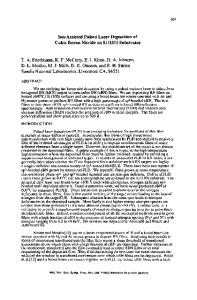Photochemical depassivation of hydrogenated (100) nitrogen surface of cubic boron nitride
- PDF / 224,146 Bytes
- 3 Pages / 612 x 792 pts (letter) Page_size
- 113 Downloads / 282 Views
MATERIALS RESEARCH
Welcome
Comments
Help
Photochemical depassivation of hydrogenated (100) nitrogen surface of cubic boron nitride Shojiro Komatsu National Institute for Research in Inorganic Materials, 1-1 Namiki, Tsukuba, Ibaraki 305, Japan (Received 8 August 1996; accepted 1 April 1997)
The passivation of the nitrogen top-layered (100) surface of cBN by hydrogen was theoretically predicted recently to be related to the difficulty of chemical vapor deposition of cubic boron nitride. The possibility of photochemical depassivation of this surface was suggested by the anti-bonding nature of the surface H–N bonds at the lowest unoccupied molecular orbital; that was demonstrated by AM1 molecular orbital calculations using large cBN clusters such as B30 N32 H64 (21) and B30 N32 H62 (2BH3 ).
Cubic boron nitride (cBN) is a unique wide band gap semiconductor material that has hardness ranking next to diamond in addition to the chemical inertness diamond does not have.1,2 Its thermal conductivity ranks next to diamond as well.3 We know that cBN can be easily doped, both n and p types, whereas diamond cannot.4,5 However, it appears that the chemical vapor deposition (CVD) method of high quality cBN films still has not been established in contrast to the case of diamond.6 We believe that the knowledge of physical and chemical characteristics of cBN surface should afford a useful insight into what is needed to grow highly crystalline cBN films by CVD. However, as far as the authors know, experimental studies of cBN surfaces are seldom performed. To serve this purpose, the authors recently investigated the structural stability of the hydrogenated (100) surface of cBN in comparison with diamond by semiempirical molecular orbital calculations employing isoelectronic large cluster models such as B52 N42 H8022n (102) , N52 B42 H8022n s101d , and C94 H8022n , where n 0, 1, 2, or 3. These clusters were nanometer-sized pyramidal crystallites bound by four h111j faces and one (100).7 cBN has two kinds of (100) surface, namely, (100)B and (100)N; the surface top layer of (100)B consists solely of boron atoms whereas that of (100)N consists of nitrogen atoms. By these calculations, hydrogenated (100)N of cBN was found to be unique because of its stable (1 3 1) : 2H dihydride structure, which retains the bulk structure truncated at the surface without reconstruction. On the other hand, hydrogenated (100)B of cBN was predicted to greatly stabilize as a (2 3 1) : H monohydride phase in the same manner that hydrogenated (100) surface of diamond reconstructs.7 J. Mater. Res., Vol. 12, No. 7, Jul 1997
http://journals.cambridge.org
Downloaded: 17 Mar 2015
We presume that the predicted (100)N surface of (1 3 1) : 2H structure is chemically inert because of the strong H–N bond, which is related to the difficulty of CVD of high quality cBN films; once that surface is formed, growth of the crystallites ceases on that surface because of the inertness. This passivation of (100)N by hydrogen is supposed to be one of the reasons why the CVD
Data Loading...











